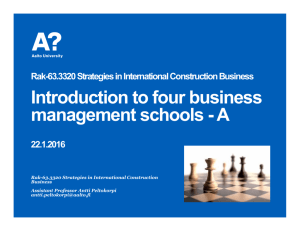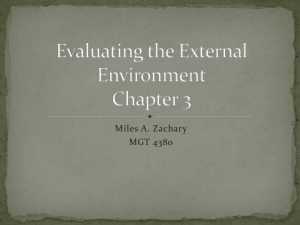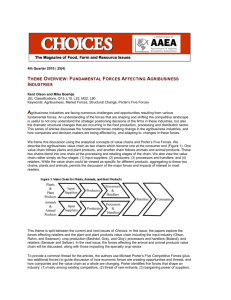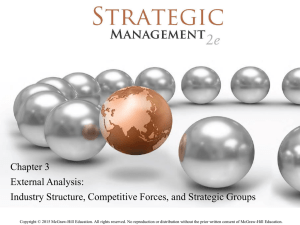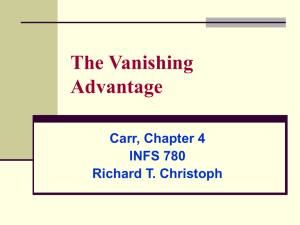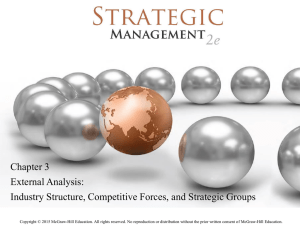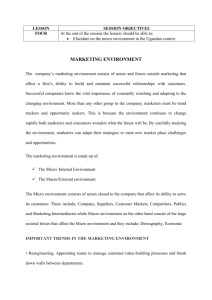Froeb_10 - Vanderbilt Business School
advertisement
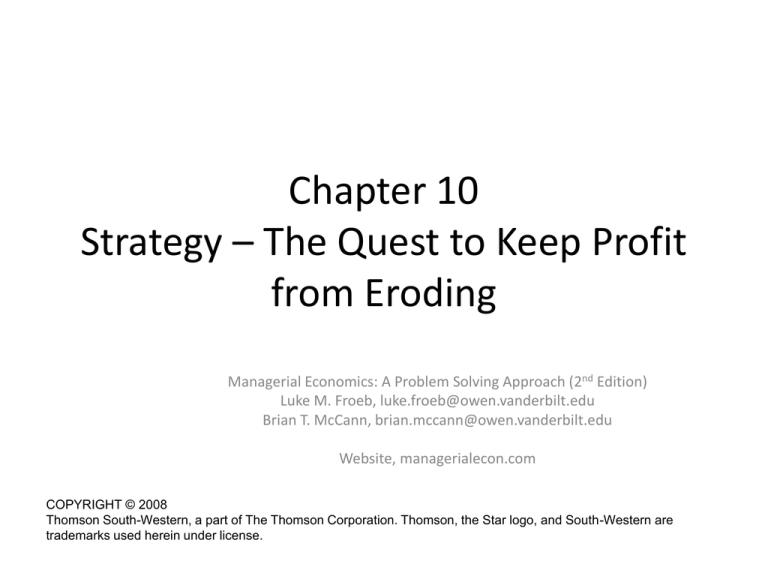
Chapter 10 Strategy – The Quest to Keep Profit from Eroding Managerial Economics: A Problem Solving Approach (2nd Edition) Luke M. Froeb, luke.froeb@owen.vanderbilt.edu Brian T. McCann, brian.mccann@owen.vanderbilt.edu Website, managerialecon.com COPYRIGHT © 2008 Thomson South-Western, a part of The Thomson Corporation. Thomson, the Star logo, and South-Western are trademarks used herein under license. Summary of main points • Strategy is simple―to increase economic performance, figure out a way to increase P (price) or reduce C (cost). • The industrial organization economics (IO) perspective assumes that the industry structure is the most important determinant of long-run profitability. • The Five Forces model is a framework for analyzing the attractiveness of an industry. Attractive industries have low supplier power, low buyer power, high entry barriers, low threat of substitutes, and low rivalry. • And cooperation from complements. (The force that Porter forgot) Summary of main points (cont.) • According to the resource-based view (RBV), individual firms may exhibit sustained performance advantages due to their superior resources. To be the source of sustainable competitive advantage, those resources should be valuable, rare, and difficult to imitate/substitute. • Strategy is the art of matching the resources and capabilities of a firm to the opportunities and risks in its external environment for the purpose of developing a sustainable competitive advantage. Summary of main points (cont.) • Be wary of any advice you read that claims to identify best practices, critical resources or capabilities that successful companies have to develop in order to gain a competitive advantage. This is the fundamental error of attribution. • To stay one step ahead of the forces of competition, a firm can adopt one of three strategies: cost reduction, product differentiation, or reduction in the intensity of competition. Introductory anecdote • In 1964, an MIT professor founded a technology company. • One year later, the company launched it’s first product – a loudspeaker with excellent technological performance. • Regardless, the loudspeaker was a complete failure in the market. No one liked the design of it and turned to complimentary products. • Four years later the company produced another loudspeaker. The company was forced to rely on door-to-door sales to convince consumer’s of the Introductory anecdote (cont.): The key to success • In 2006, a survey of American households found that consumers voted this company the most trusted technology brand. • How did they achieve this success? • According to the company’s former president: “'Our challenge is to prod people into being innovative and using their creativity to do something that's better. In the long run, this is the source of sustainable advantage over our competition.” Sustainable Competitive Advantage • Succeeding in a competitive market requires a company to find and protect an advantage. • Warren Buffett’s most important investment criterion: “sustainable competitive advantage." • SCA creates a “moat” around the company to help protect its profits from the forces of competition. • A company's prosperity is driven by how powerful and enduring its competitive advantages are. • Stock price = discounted flow of future profits • The challenge is to keep profits from eroding Strategy – Trying to Slow Erosion • Firms have a competitive advantage when • They can price lower than competitors • Or they can offer a superior product at a similar price to competitors • Strategy is about raising price or reducing cost. Really successful firms manage to do both. Strategy (cont.) Sources of economic profit • What is the key to competitive advantage and positive economic profit? • Two schools of thought • Industrial organization (IO) economics – choose the right industry. • Resource-based view (RBV) – build the right firm. Industry (IO) view of strategy • Industry is the key issue – focuses on the external environment. • Industry structure determines the conduct of firms, which in turn determines their performance. • Typical structural characteristics that are of interest to IO researchers include barriers to entry, product differentiation among firms, and the number and size distribution of firms. IO view of strategy (cont.) • The key to generating economic profit for a business is its selection of industry. According to the Five Forces model of Michael Porter, the best industries are characterized by: • • • • • • High barriers to entry Low buyer power Low supplier power Low threat from substitutes Low levels of rivalry between existing firms (Cooperation from complementary products) • So, the advice is to pick a good industry and work to make it even more attractive. Using Five Forces • Definition: An industry is comprised of a group of firms producing products that are close substitutes to each other to serve a particular market. • Note: For a multi-product company industry analysis may need to be done on a productby-product basis. • To use the Five Forces model, one must consider “value capture.” • Value is created in each industry and distributed across suppliers, industry rivals, Five Forces (cont.): Buyers and Suppliers • Suppliers • are the providers of any input to the product or service • power tends to be higher when the inputs provided are critical inputs or highly differentiated • Concentration among suppliers gives suppliers power because a firm will have fewer bargaining options. • Even if many suppliers exist, power may still be high if there are significant costs to switching between suppliers. Five Forces (cont.): Entrants • Economic profits tend to draw new entrants • Entrants erode the profit of an industry, so barriers are made to prevent, or slow, their entry. Some barriers are, • government protection (e.g., patents or licensing requirements) • proprietary products • strong brands • high capital requirements for entry • lower costs driven by economies of scale. Five Forces (cont.): Rivalry • If a large number of firms compete in an industry with high fixed costs and slow industry growth, rivalry is likely to be quite high. • Rivalry also tends to be higher when products are not very well differentiated and buyers find it easy to switch back and forth. Support for the IO View • Profitability differences do exist across industries Limitations of Five Forces • This view portrays an industry as a zero-sum game. • i.e., the way you get a bigger piece of the pie is to take it from one of the other participants in the industry • Although this is one way to view competition, companies can also work with other industry participants to try to build a larger pie. • With a larger pie, everyone’s slice grows bigger • Some economists recommend that as a The force that Porter forgot • Preston McAfee was the first to realize that Michael Porter's famous industry analysis leaves out one crucial force: cooperation from complements. • A company must decide whether to pursue a "product" or a "platform" strategy: • “Put simply, a product is largely proprietary and under one company’s control, whereas an industry platform ... requires complementary innovations to be useful, and…is no longer under the full control of the Platform strategy • If you decide on a platform strategy, there are two recommended strategies • "Coring” - using a set of techniques to create a platform by making a technology "core" to a particular technological system and market. ... Examples of successful coring include Google Inc. in Internet search and Qualcomm Inc. in wireless technology. • "Tipping” - the set of activities that helps a company "tip" a market toward its platform rather than some other potential one. Examples of tipping include Linux's growth in the market for Web server operating systems The Resource-Based View • According to the resource-based view, individual firms may exhibit sustained performance advantages due to the superiority of their resources (internal focus) • Resources are defined as “the tangible and intangible assets firms use to conceive of and implement their strategies” • Two primary assumptions underlie the RBV: • resource heterogeneity (firms possess different bundles of resources); • resource immobility (since resources can be immobile, these resource differences may persist). The Resource-Based View (cont.) • If a resource is both valuable and rare, it can lead to at least a temporary competitive advantage over rivals. • A valuable resource must allow a business to conceive of and implement strategies that improve its efficiency or effectiveness. • Examples include resources that let a firm operate at lower costs than its rivals or charge higher prices to its customers. • For a resource to be rare, it must not be simultaneously available to a large number of competitors. The Resource-Based View (cont.) • Resources that may generate temporary competitive advantage do not necessarily lead to a sustainable competitive advantage. • SCA requires that resources must be difficult to imitate or substitute. • Some conditions that make a resource hard to imitate are, • Resources that flow from a firm’s unique historical conditions will be difficult for competitors to match. • If the link between resources and advantage is ambiguous, then competitors will have a hard time trying to re-create the advantage. • If a resource is socially complex (e.g., The Resource-Based View (cont.) • So from the resource based view perspective, resources and capabilities that are valuable, relatively rare, and difficult to successfully imitate/substitute are at the core of sustained, excellent firm performance • These resources and capabilities may include: • • • • • • technology physical capital intellectual assets human capital financial resources organizational excellence Some advice you can follow • Be wary of any advice that claims to identify critical resources or capabilities that successful companies have to develop in order to gain a competitive advantage. • explanations such as these often mistakenly conclude a causal relationship when only a correlation exists. • Publicly available knowledge is not going to help you create a competitive advantage. • For example, you read that having a CMEO (Chief Managerial Economics Officer) in your company leads to a competitive advantage. You decide to hire a CMEO for your business and no competitive Generic Strategies • There are three basic strategies a firm can follow to generate better economic performance and keep ahead of competitors. • Reduce costs • Reduce intensity of competition • Differentiate product • Example: Perdue Chicken – successful differentiation • Example: Prelude Lobster – fruitless attempt at differentiation 1. Introduction: What this book is about Managerial Economics 2. The one lesson of business 3. Benefits, costs and decisions Table of contents 4. Extent (how much) decisions 5. Investment decisions: Look ahead and reason back 6. Simple pricing 7. Economies of scale and scope 8. Understanding markets and industry changes 9. Relationships between industries: The forces moving us towards long-run equilibrium 10. Strategy, the quest to slow profit erosion 11. Using supply and demand: Trade, bubbles, market making 12. More realistic and complex pricing 13. Direct price discrimination 14. Indirect price discrimination 15. Strategic games 16. Bargaining 17. Making decisions with uncertainty 18. Auctions 19. The problem of adverse selection 20. The problem of moral hazard 21. Getting employees to work in the best interests of the firm 22. Getting divisions to work in the best interests of the firm 23. Managing vertical relationships 24. You be the consultant EPILOG: Can those who teach, do? 27
